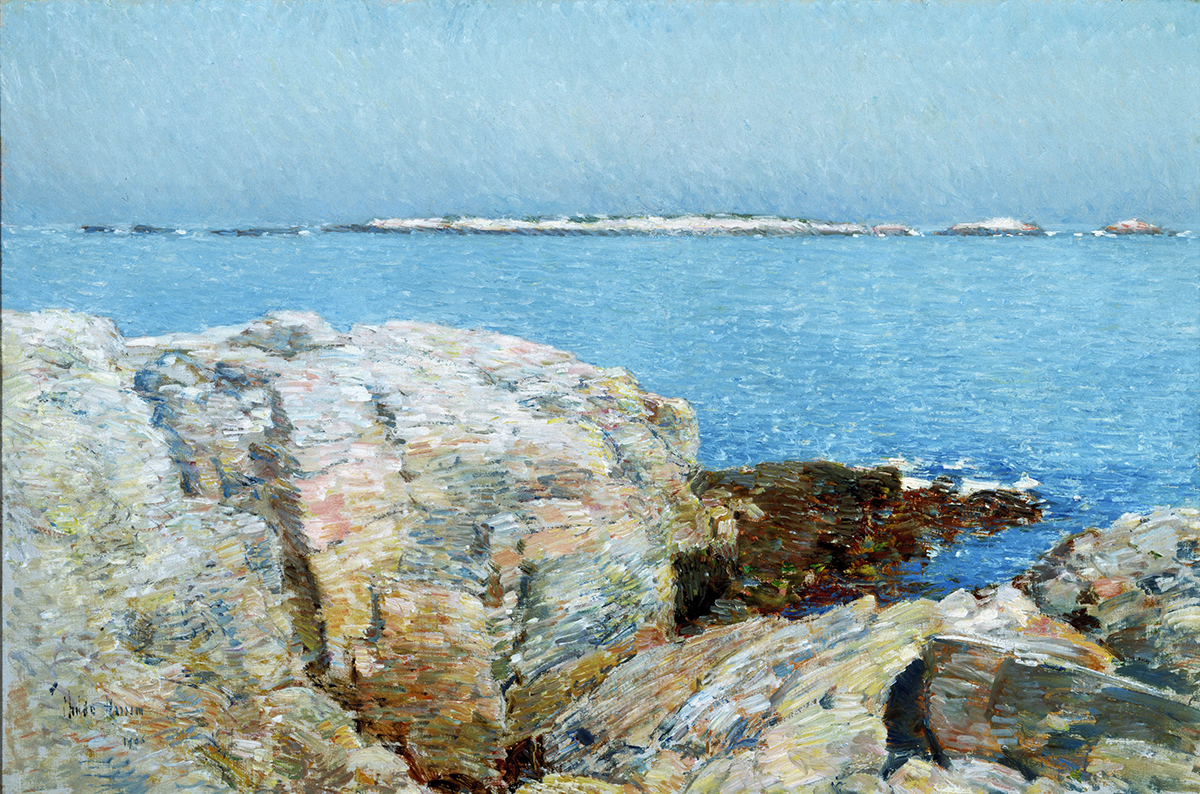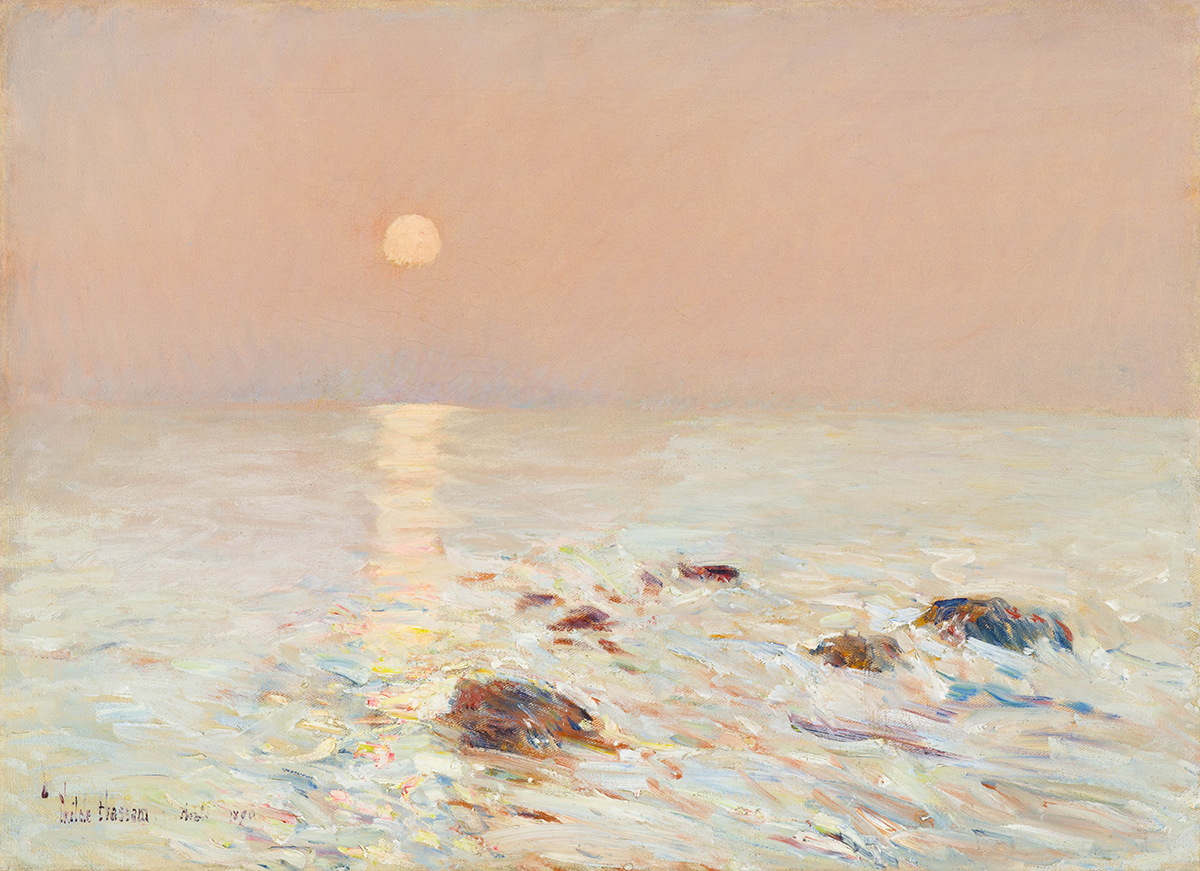PEM Welcomes New Exhibit Featuring Childe Hassam’s Paintings of Appledore

Childe Hassam. Duck Island, 1906. Oil on canvas. 20 1/2 × 31 1/2 in. (52.2 × 80 cm). Dallas Museum of Art, Bequest of Joel T. Howard, 1951.41. Courtesy of Dallas Museum of Art
A new Peabody Essex Museum exhibit transports viewers to Appledore, a tranquil island off the coast of Maine in the Isles of Shoals. Soundscapes of waves and seagull calls, teak benches, photographs by contemporary artist Alexandra de Steiguer, and the paintings of American impressionist Childe Hassam create this evocative multisensory experience. It’s also multidisciplinary. The Peabody Essex Museum (PEM) and North Carolina Museum of Art collaborated with the Shoals Marine Laboratory to explore Hassam from a scientific perspective—something that’s never been done before.
The Hassam exhibit began at the North Carolina Museum of Art under curator John Coffey. Coffey was working with a couple of Hassam’s paintings from Appledore, and asked a colleague at the Shoals Marine Laboratory to help him locate what on the island the works were depicting. Soon enough, Coffey found himself traveling up the coast to the Isles of Shoals. “I’ve never denied an invitation to a Maine island before,” Coffey jokes. On the island, Coffey ventured out on the rocks to search for answers to simple questions like “just figuring out where Hassam put his butt when he was painting.”
Prosaic inquiries like this led to deeper realizations about Hassam’s artistic process. “What has been extraordinary is to understand the ways in which the scientists are able to look at his paintings and see the kind of rock, the glacial striations, the algae placement in an intertidal zone,” Austen Bailly, curator of American Art at PEM, says. “We’re able to appreciate the ways in which he’s both impressionistic but also a realist in how he’s so carefully observing the landscapes and the sea. That tension between what we think of as plein air painting, with the light and color, with the rigor of what he’s representing, adds a completely new dimension and really much richer way to think about his art and his interests.”

Childe Hassam. Morning, Isles of Shoals. 1890. Oil on canvas. 16 1/4 × 22 1/4 in. (41.2 × 56.5 cm). North Carolina Museum of Art, Raleigh, Promised gift of Ann and Jim Goodnight
Jennifer Seavey, executive director of the Shoals Marine Laboratory, was not at all surprised that the artist-science collaboration was so fruitful. Working with the artistic community only helps along the lab’s work. “You’re filled with that reverence again,” she says. “When you’re taking data, you get drilled in the specifics of what you’re measuring and don’t look up at the 20-foot cliff and view. … I’ve often had a foot in both worlds, and I don’t think they’re that different. I think they’re both connected in asking the big questions and the mysteries of the world, like what is truth.”
Understanding Childe Hassam and this alluring island may be a smaller mystery of the world, but still, the team took it on with full vigor, as the project stretched out across four summers. Coffey was amazed as he realized the extent of Hassam’s aims. “He was painting cumulative mosaic portrait of Appledore over 30 years…This one rock out there in the Atlantic had an inordinate impact on American art, far in excess of its size.”

Childe Hassam. 1859 – 1935, United States. Poppies, Isles of Shoals, 1891. Oil on canvas. overall: 50.2 x 61 cm (19 3/4 x 24 in.) framed: 73.5 x 83.8 x 6.7 cm (28 15/16 x 33 x 2 5/8 in.). Gift of Margaret and Raymond Horowitz. 1997.135.1. Courtesy National Gallery of Art, Washington D.C.
The contemporary photographer Alexandra de Steiguer provided unique insight as both an artist and for 19 years the winter caretaker and sole inhabitant of Starr’s Island, another landmark in the Isles of Shoals. “You’re going to a place of wildness that’s out on a hairy edge,” she said of Appledore’s appeal. “We all emerge from the sea at some point. There’s something reconnecting about going back to a place surrounded by water.”
Discovering Hassam’s work and later working on this exhibition only deepened her connection to place. “It was like finding a kindred spirit,” Steiguer says. She describes walking in his footsteps on the rocks in the summer—a season that she typically spent away from her winter island home. “I was able to see it full color.”
Bailly describes de Steiguer’s photographs as “a fascinating counterpoint. Her connection to place is deep and strong like Hassam’s, but also different.” Bailly was amazed at what the exhibit was able to unearth, even referencing discoveries about 19th-century poet and Appledore resident Celia Thaxter. “It connects to science today and poetry of the past. It really collapses the historical distance.”
If the exhibit moves viewers the way Appledore has shaped so many artists and scientists, postcards of the island will be available for visitors to express their responses. These postcards can either add to a scrapbook or be stamped and mailed out from within the museum. “We’re hoping that people will feel inspired to share their experiences or their responses to Hassam’s art with the world,” Bailly says.
“American Impressionist: Childe Hassam and the Isles of Shoals,” July 16-November 6, Peabody Essex Museum, East India Square, 161 Essex St., Salem, pem.org.


